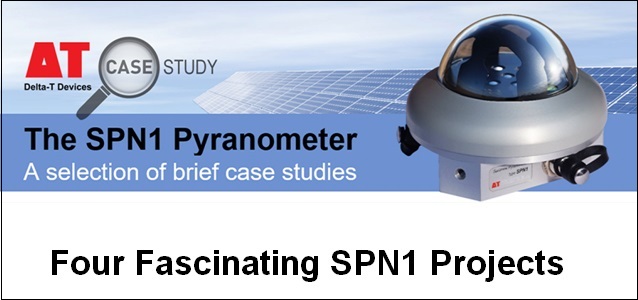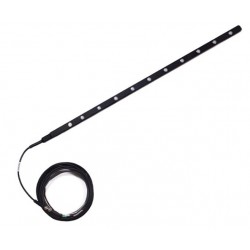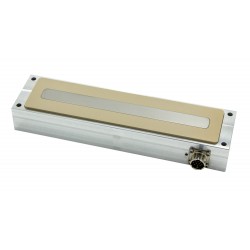SPN1 Solar Pyranometer for Global/Diffuse Radiation (0 to +2000 W.m-2)
- Measures solar radiation and sunshine duration
- Global (Total) and Diffuse irradiance in W.m-2
- DNI (Direct-Normal Irradiance) calculation
- WMO sunshine threshold: 120 W.m-2 direct beam
- No moving parts, shade rings or motorised tracking
- No routine adjustment or polar alignment
- Works at any latitude
- Precision ground glass dome
SPN1 Sunshine Pyranometer
The SPN1 Pyranometer is exceptionally easy to use; it needs no routine adjustment or polar alignment and works at any latitude.
An internal heater keeps the pyranometer dome clear of dew, ice and snow down to -20°C (in still air conditions), ensuring reliable readings in difficult climatic conditions. The pyranometer design is protected by patents EP 1012633 and US 6417500.
Included with the Sunshine Pyranometer:
Fitted with 5 and 8 pole M12 plugs.
It is supplied with a 5m signal and power cable to bare wire type SP-BF/w-05, 1.5 comms cable type SP-BF-RS01, a spare desiccant unit, a Quick Start Guide and a calibration certificate.
Note: the SPN1 requires either an SPN1/BP baseplate or an SPN1/ARM support arm - see Accessories (ordered separately).
SPN1 Pyranometer Resource Centre
The Resource Centre contains a wide range of application and technical information for the SPN1 – covering DNI calculation, tilt correction, performance validation, and much more.
The SPN1 Sunshine Pyranometer is a meteorological class solar radiation measurement instrument with a built-in heater, and is designed for long-term outdoor exposure. It is an affordable and effective alternative to shade-ring pyranometers, pyrheliometers and traditional sunshine recorders. The SPN1 Sunshine Pyranometer is exceptionally easy to use; it needsno routine adjustment or polar alignment and works at any latitude.
The SPN1 Sunshine Pyranometer is protected by patents EP 1012633 and US 6417500.
An internal heater keeps the pyranometer dome clear of dew, ice and snow down to -20°C (in still air conditions), ensuring reliable readings in difficult climatic conditions.
Direct and Diffuse Radiation
The SPN1 Sunshine Pyranometer uses an array of seven miniature thermopile sensors and a computer-generated shading pattern to measure the direct and diffuse components of incident solar radiation. The SPN1 Pyranometer computes direct radiation by subtracting the diffuse from the global (total) radiation.
Sunshine Duration
The WMO threshold for bright sunshine is 120 W.m-2 in a plane perpendicular to the direct solar beam. The SPN1 Pyranometer uses an algorithm based on the ratio of direct to diffuse radiation, combined with their absolute values, to estimate sunshine duration to within a few percent of the WMO standard.
The SPN1 Sunshine Pyranometer does not need to be adjusted or repositioned to track the sun - a distinct advantage over devices with shadow rings. There are no complex electro-mechanical assemblies and no burnt paper tracks to interpret.
Outputs and Logging
The SPN1 Sunshine Pyranometer provides 2 analogue voltage outputs for global and diffuse radiation, and a digital output for sunshine duration, which can be connected to data loggers, such as the Delta-T Devices DL2e and the compact GP1.
Readings can also be obtained directly from the RS232 port and viewed/logged using the SunData software supplied.
The GP1 Data Logger from Delta-T Devices is a powerful general purpose data logger that provides a low cost logging solution for the SPN1 Sunshine Pyranometer.
Applications
The SPN1 is ideally suited to multiple solar radiation measurement application areas, including PV (photovoltaic) efficiency monitoring, air pollution studies, cloud cover research, ET and heat flux studies, canopy analysis, and building energy management systems.
Calculating DNI
Direct-Normal Irradiance (DNI) is the amount of solar radiation in unit time at the Earth's surface on a unit area perpendicular to the direction to the Sun. It is a common practice to compare solar panel efficiency to DNI, particularly in field trials. Output from an SPN1 allows calculation of DNI in sun tracking, horizontal and tilted installations.
Read more about the SPN1 Pyranometer and DNI Calculation in the 'SPN1 Technical Fact sheet' – downloadable from our Further Information section (SPN1 Datasheets) to the left.
Note: You can download an Excel spreadsheet add-in to calculate DNI from the output of a horizontally mounted SPN1 Pyranometer.
SPN1 Pyranometer - comparison with BF5 Sunshine Sensor
The SPN1 Pyranometer is a precision version of the BF5 Sunshine Sensor and although the two instruments have some features in common, there are important differences.
For simultaneous outputs of total radiation, diffuse radiation and sunshine status.
| Overall accuracy: Total (Global) and Diffuse radiation |
±5% Daily integrals ±5% ±10 W.m-2 Hourly averages ±8% ±10 W.m-2 Individual readings |
| Resolution | 0.6 W.m-2 =0.6 mV |
| Range | 0 to >2000 W.m-2 |
| Analogue output sensitivity | 1 mV=1 W.m-2 |
| Analogue output range | 0 – 2500 mV |
| Sunshine status threshold | 120 W.m-2 in the direct beam |
| Accuracy: Sunshine status | ±10% sun hours with respect to the threshold |
| Accuracy: Cosine correction | ±2% of incoming radiation over 0-90° Zenith angle |
| Accuracy: Azimuth angle | ±5% over 360° rotation |
| Temperature coefficient | 0.02% per °C (typical) |
| Temperature range | -40 to + 70°C |
| Stability | Recalibration recommended every 2 years |
| Response time | 100 ms (typical) |
| Spectral response | 400 – 2700 nm |
| Spectral sensitivity variation | 10% (typical) |
| Non-linearity | < 1% |
| Tilt response | Negligible |
| Zero offsets | < 3 W.m-2 for a change of 5°C/hr in ambient temperature < 3 W.m-2 dark reading |
| Latitude capability | -90° to + 90° |
| Environmental sealing | IP67 |
| Sunshine status output | No sun=open circuit Sun=short circuit to ground |
| Power requirement | 2 mA (awake ), <30 µA (asleep) 5 V – 15 V DC |
| Heater power | 12 V – 15 VDC, up to 1.5 A |
| RS232 connector | 5-pin M12 |
| Signal output & power-in connector | 8 pin M12 |
| Mounting options | 3 x M5 tapped holes in base at 108 mm dia, 120° spacing |
| Size & Weight | 126 mm dia. x 94 mm high, 786g |
Note: The EXT/8W-xx range of cables were previously known as the EXT/M12-xx range.
- The Sensor measures:
- Solar Light Radiation W/m2
You might also like





















.jpg)
.jpg)
.jpg)
.jpg)
.jpg)
_1.jpg)
_1.jpg)
_1.jpg)










































